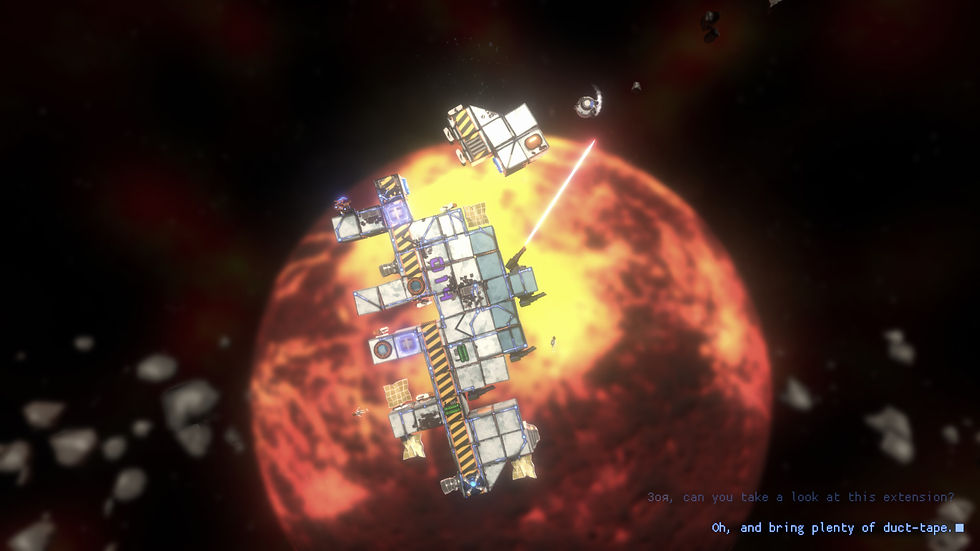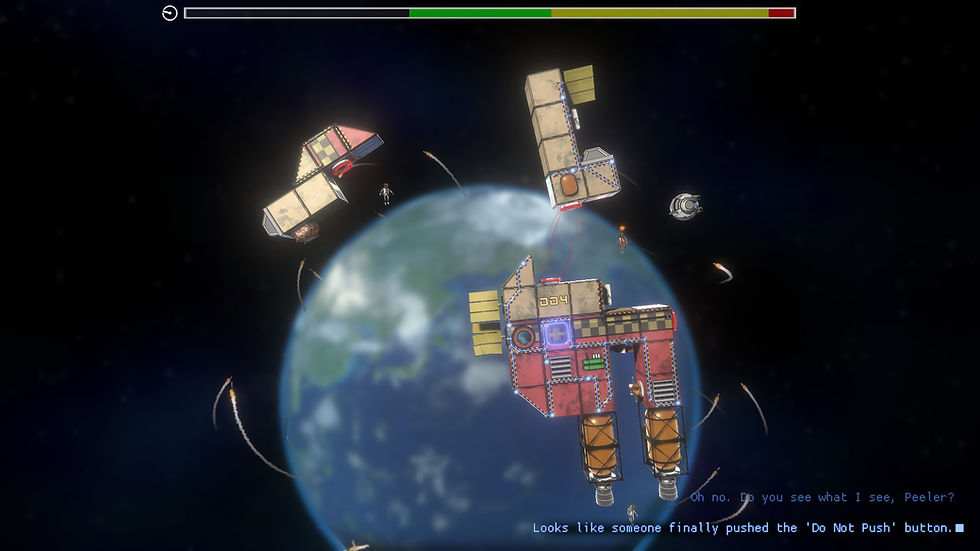Review: Kosmokrats
- Roberto Nieves
- Dec 6, 2022
- 5 min read

Video games can be absolutely anything. They can be wild and crazy, and they can be overwhelmingly serious. There are games about the darkness of mental health, such as Hellblade, and games that don't give a damn about what the censors say, like Bayonetta. Video games can be a campout with spirits, like in Cozy Grove, and be an all-out balls-to-the-walls carnage fest like in Doom Eternal. Then, you come across a game like Kosmokrats, a game so special and articulate it reminds you about the wonders of video games in the first place.
It is the 1980's. It is the future. The future belongs in space. To the Communists, space is a place to prosper, expand the motherland, and support the people through the important art of potato peeling. The Communists loathe the Capitalists in the West and will stop at nothing to reign supreme. As the former drone pilot had some "complications," the Soviets recruit a potato peeler to operate the cutting-edge drone. At first, things go smoothly for the Soviets in space, and using the drone is a success. Soon enough, tensions boil over, and nuclear war erupts. Many Soviets manage to get to space, but many more don't make it due to the calamitous delivery system. The Capitalists make it into space as well. With the Earth lying in total ruin and forever uninhabitable from nuclear waste, humanity takes a chance in the stars. What begins as a space race soon becomes an intergalactic journey of calamity and cosmic mishaps of biblical proportions.
Kosmokrats begins as a zero-gravity puzzler, where players see themselves promoted from lonely potato peeler to advanced drone pilot. The goal of each level is to assemble pieces of space technology in zero gravity. This includes assembling defense systems, mining equipment, and other special spacecraft to increase the Communist fleet. Shortly after the first few levels, and when the Cold War's calamity begins, players can alter the course of their adventure, making key decisions mid-mission that affect the entire outcome of the story. Between missions, players "debug" their drone with a retro-futuristic puzzle game and make sacrificial decisions regarding their piloting in the name of the Communist Empire. Some of these decisions involve cost-cutting measures, such as no guidance to assembling pieces and not having enough potatoes to eat, losing focus on the mission. Each mission remains the same, but certain variables will be introduced into the mission. Cosmonauts float freely but must be protected. Batteries can overload and explode, causing widespread, extensive damage to the spaceship. Bins of raw sewage can rupture and slow down the drone. Any number of things can happen, and each run in Kosmokrats brings great surprise.
The early missions in Kosmokrats are simple enough for any player to understand, but soon enough, the challenges begin to ratchet up. Each mission randomly places the necessary parts across the level, meaning each time a player starts up, the arrangement of parts are scattered. Players are timed on each mission. The longer they take, the further their orbit decays into the atmosphere of the celestial body being orbits. Players work fast to avoid this, but if time runs out, the parts are lost, and the mission is a failure. Too many failures and the entire adventure ends.

The fundamentals are only the beginning of the gameplay attributes in Kosmokrats. Cosmonauts protest your progress, calling for a union and blocking your progress. Computers designed for assistance become self-aware and incredibly intelligent. Unstable nuclear reactors, if not connected to the right power supply, can completely destroy an entire section of the spaceport. Kosmokrats works to introduce many other challenges to keep things interesting and players busy, making each level something familiar but unexpected. Furthering the challenge are the rogue-lite mechanics thrown into the mix. At certain points, sacrifices must be made, and players choose a detriment to their operation. It could be faster orbital decay or the removal of color coding to make assembly challenging. On the contrary, there are opportunities to debug the drone through a puzzle minigame. Successfully debugging the drone yields special benefits, such as a fully charged drone between missions and faster thrusters for maneuvering. Failure will happen, and often in Kosmokrats, tempting players to quit and reload a save, but failure isn't the worst thing. Failure can lead to another alternate ending and to different routes that can be taken. Additionally, players can restart chapters if players wish to undo and redo a decision.
Between missions, players can observe life in space through the comfort of their own quarters. There are some silly distractions here, such as playing minigames on a computer resembling an early 80s IBM machine and putting wallpaper on the wall. Players also observe the total collection of medals to earn in Kosmokrats and choose to drink coffee, vodka, or both. The changes of the quarters are noticeable as the game continues and provide a fun shift from the main campaign.
Kosmokrats is an enigma, not because it's a puzzle game at heart. It's an enigma in that it starts as a simple space-borne puzzle game but immerses itself into much more. Kosmokrats is a space opera. Kosmokrats is an action-comedy. Kosmokrats is a puzzle RPG. These definitions and many more can be applied to this game. That fact makes Kosmokrats one of the most unique games around.

Of course, many other video games combine various elements to become strongly distinct adventures, but where Kosmokrats does it right is in its balance. A common observation of video games combining different elements is that one element may become far stronger than the other. With Kosmokrats, you have a sublime formation of various elements. Kosmokrats features a thought-out story, with a multitude of paths depending on your choices and success in missions. The puzzle-solving gameplay is a remarkable twist on Tetriminos, and the minigames are a fun enjoyment as well. Even the presentation, with its South Park-like visuals and amazing synthwave soundtrack, evokes the deepest depths of the spirit of The Cold War in the 1980s. Kosmokrats is a game dripping with the enthusiasm and commitment not just to make a game but make an unforgettable experience unlike any other. Throughout my time in Kosmokrats, I constantly smiled and laughed at various absurdities. Cyborg uprisings, corrupted elections, terrible quotes and words of wisdom, and so much more encompass the comedy of Kosmokrats. Of course, the constant focus on potatoes and potato peeling had me laughing pretty hard toward the end of the game.
Overall, the gameplay is a case of easy-to-learn yet hard to master, but overall, it is a barrel of fun all the way through. It's a tremendously fun game that keeps players engaged and satisfied, even when they lose a level. It's something in gaming these days to have an experience that can be challenging but remains consistently fun and rewarding, and that is the markings of a great game.
Kosmokrats is a game that falls into a category, unlike anything I have ever played. It's witty, fun, and exciting to play, as well as endearing in its story and adventure. It's a tale that entertains and encourages players to be loose and have fun. Kosmokrats is a great title and easily one of the best titles on Nintendo Switch. Peel those potatoes and prepare to go on a quest unlike any other.
Kosmokrats was reviewed on the Nintendo Switch thanks to a key generously supplied to Stack Up by Publisher Modern Wolf.


Comments